These are the puzzles that have been solved.
This image was sent in by Angela Brown, who wanted to know what the inscription on the bracelet means.
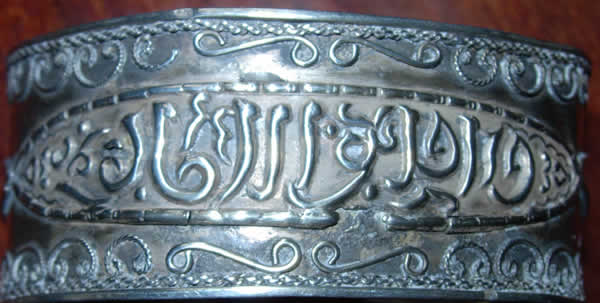
Evans Knight suggests that the inscription doesn't actually say anything at all. It seems that it was just arbitrarily designed to simulate the Arabic script.
Aizuddin believes that the writing might be لا إله إلا الله (Lailahailallah) which means "There is no God but Allah".
Jacob McLanth thinks that the writing might be a copy of an Avestan (Old Persian) inscription, with some possible Devanagari and Tibetan elements. Alternatively it might be a version of the Manichaean alphabet.
According to Mohammad Altremat, the inscription reads "واحد الله وبالله الأمان", which means "the god (Allah) is one, and by Allah is safety", so this bracelet is designed to keep its owner safe.
The image below was sent in by Joan Bricollé, who wanted to know what language the text on this postcard is in, and what it says.

The language is Catalan (slightly influenced by Castilian Spanish), enciphered with a simple substitution cipher, which is as follows:
A: I B: V C: S D: P E: U F: L G: Z H: F I: A L: R LL: M M: LL N: K O: E P: B Q: C R: D S: G T: J U: O V: Ñ X: Q
Ageraki... ! Purade llerj cou g'isi- vak icoujg paig p'isgukgai... Dúg, jdeve cou ka jik gerg bozoa sellbidid-fe iv ri juñi sell- bik[?]ái... Ke jdeve iragaukj uk mes, ka dúg llu pagjduo. Ujg jó, ri okási budgeki cou'll li biggid urg dijég lurageg. ¡Coik dusedpe ur pallusdug i ri jidpu...! Ga fizougag ñakzoj iv lla sell puaig, ll'i- zdipidái llug icougj bevru, cou idi r'ivodduage...
Isolina...! Deliro molt que s'aca- bin aquets dias d'acsencia... Rés, trobo que no tan sols pugui comparar-ho ab la teva com- panyía... No trobo alisient en lloc, ni rés me distreu. Ets tú,, la uníca persona que'm fa passar els ratós felisos. ¡Quan recordo el dimecres a la tarda...! Si haguesis vingut ab mi com deias, m'a- gradería mes aquest poble, que ara l'aburreixo...
Isolina...! Deliro molt que s'acabin aquests dies d'absència... Res trobo que ni tan sols pugui comparar-ho amb la teva companyia... no trobo al·licent enlloc, ni res em distrau. Ets tu, l'única persona qu em fa passar els ratos feliços. ¡Quant recordo el dimecres a la tarda...! Si haguessis vingut amb mi com deies, m'agradaria més aquest poble que ara l'avorreixo.
Isolina! I am very much delirious about these days of absence coming to an end. I find nothing that I can even compare to your company... I can find no charm anywhere, and nothing entertains me. It is you, the only person that makes me spend happy moments. I remember Wednesday afternoon so much! If you had come with me as you said, I would like more this village that I currently hate.
The rendition of the text in standard Catalan and the translation into English were done by Manuel Hurtado Ferrández and Dago Lesmes. The cracking of the cipher was begun by David Salo and completed by them. Any errors or omissions are strictly David's fault.
The item pictured below was found hanging in a tree in Cheltenham, England in the 1980s by Kelly Bevan. On the manuscript contained within it is a text in an unknown language. Kelly has been told that the script is an early form of Devanagari and that the text might possibly be a Pali commentary on a Tibetan document. If you can add any further information, please contact Kelly at: kellyyoung60@hotmail.com

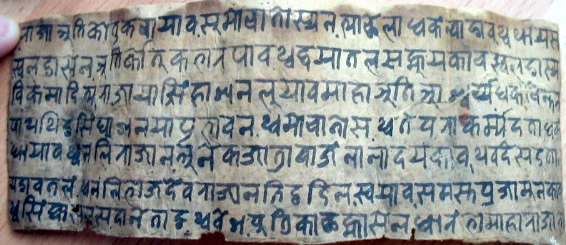

According to Aniruddha Basu, the script is a form of Nagari (may be eastern Nagari - mother to modern Bengali, Oriya and Assamese scripts) and he thinks that it would date from around 9th to 10th century, may be even a bit later, considering the development of its letters.
As for the language, he recognises certain conjuncts and syllables that would be pronounced "sva", "shvaryya" "karmya" etc., which do not appear in Pali. He thinks he also recognises some words such as "raajaa" = king; "svabhaava" = a person's nature; "smasta-prajaa" = all the king's subjects; "simhaasana" = king's throne. Maybe it is written in some mid-late Middle Indo-Aryan language (1st - 11th century CE), but he's fairly sure that it's not Pali.
According to Arun Upadhyay: This is the Devanagari script used in Rajisthan and Bihar from 1700-1900. Later type faces changed the shapes of some letters. It indicates the names of some kings: Vikramaditya (second part), Lunakaran (some kings of Rajsthan-named after the Luni river). Some words like Simhasana = throne, Patrika (letter, circular), Ju = word of respect for kings). This could be a letter sent in that wooden box. Some letters/words are missing, so the complete meaning is not clear. The letter 'R' is now similar in the Bengali script.
Here's a puzzle sent in by Adam Epstein . This is an inscription on one of three of the Japanese Emperor's royal items. It is the back of a mirror, some say it holds the key to the origin of the Japanese people. This sketch was taken by a general who was allowed to see the mirror, so it may not be completely accurate. If anyone can figure out the letters or meaning that would be great. Some say the middle letters are Hebrew (spelling alef, yud, daled and yud kay vav kay, meaning Light of G-d), but it's a stretch.

According to Avery Morrow, the answer to this puzzle can be found in Takenouchi Documents II. The drawing was made not by a general, but by a sort of ancient astronaut called Yano Yutaro. Furthermore, Yano's drawing was secret, and the drawing on this website was published not by him but by another researcher named Wado Kosaka who wrote the book.
The characters are what Yano called "Hifu characters", a type of script only he could read. According to Wado, Yano transliterated the characters as follows:
Amahikamikiorakakamini
Tamatsurukihitorisumirayokakerumonaku
Wareonarukashi
Translation: Heavenly Sun god gave a mirror, necklace and sword, the three sacred treasures, which are the most sacred treasures in the world. The Sumera-Mikoto was determined to be the only eternal one under heaven. Look at the mirror as you look at me, the Heavenly Sun god.
This is what Wado says Yano drew. There's another person named Mori Arinori, a Meiji-period Minister of Education who claims to have seen the words "I AM THAT I AM" in Hebrew on the back of the mirror.

These characters appear on a vase belonging to Deborah Moses.
According to Michael DePaula, the characters appear to be 陶瓷 (táocí), which mean "ceramics".

According to Teresa Alvarez, the shorthand is Gregg, most likely the version taught from 1949 through the mid 1960's.
We marched down in front of a long cutter and the main (street _____) behind the cutters looked at our ______ on our bow and threw things into this matters to have ….. as a bag. We then marched into a room and cut in front of a bin like compartment where we try on clothing as it was cold out to us. In fact, we had to put on and take off clothing fastly then there was _______ too much up to put man’s _____ out the orders. If anything failed to fit we then had to exchange it and as I hid entering to exchange the clothing was then taken into a stenciling room and a man there stenciled on my clothing MAUK ____ B. The last thing we ____ were the materials below and some wool blankets. Those on a ……. heavily over to the barracks with it having them drag on the ground. [2 sentences omitted here –indecipherable] We had Jack/Jake and then our pictures were taken for our ID card. All of them looked like convicts ….. T.B. 4 taken out of medical lan/lane(?) … the … grow in his nose and he spent only the … night in the brigs with us and we went to the hospital there at _____ Lakes. I never saw him from then on as he was in … company … We only spent one night on main side and next day we were marched over to the Green Bay by our C.O. We march into their empty barracks and check bunks … and we had our Billet No (Bunk No 81) issued. ____ on local bunk of the two deck bunks we slept in. Our CO Mont Heard SPA3/C
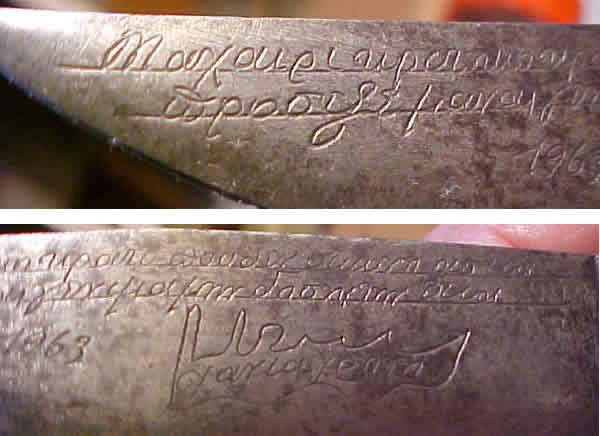
According to Panos, the inscription reads:
"mahairi kritiko krato pou den (I 'm holding a Cretan knife)
"sikoni astia (.) prosexe mannas (who take no jokes)
"genima min dosis tin aitia" (Be careful mothers birth, don't give me the quarrel)

The second character with 'fine floss, mì' radical 120 and 'see' radical 147 (but more below) is pronounced in pure Japanese mayu [stress on first syllable] or Chinese jian (with low rising tone), meaning a 'cocoon'. The first character is indeed 'govern, cure, heal, manage' but in Chinese, zhì (falling tone) also means 'to unravel (silk)', and so the disyllabic phrase means 'to unravel a cocoon'. That jian3 is actually a grass radical top, radical 140; a border prairie radical 13; a centered downward bar; a left inside floss radical 120; a right inside worm radical 142, but old texts also show it to be 'floss + see (phonetic)'.
According to Ryusei Yamaguchi the charcter on right is 親 (relatives, parents; intimate). The name is 親治 and it might be read ちかはる(chikaharu).

TJ believes that the letters are Old Cyrillic.
Another suggestion (from Anon):

Notes
One has to remember that scribes were not always consistent with letter shapes, which I also already pointed out in one of the notes. In some birch bark letters an q-shape actually represents a, and a H-shape may actually represent the Russian tse (Russian: ц; Latin: ts) while the tse-form in turn sometimes represented a Russian en (Russian: н; Latin: n) So one must obviously have a longer text to see and figure which shapes are used for what.
Looking at the transcribed texts don't make much sense, true. Clusters of vowels and consonants with no real meaning. It could mean four (or more) things: 1) It could be random letters written just for the purpose of the decoration, and if the scribe was illiterate and had to depend on a bad memory, it could explain the various shapes; 2) The letters may not have been based on sounds, but rather numerals, using the Cyrillic numerals. However, some of the shapes are not known to have any common value, which is why I have used a question-mark in the image. Also, I wasn't able to make sense of the numbers, I couldn't even fetch a date or year out of it; 3) The various letters could have inherited vowels, based on the letters' names; 4) It could be a mix of written words, acronyms and ligatures, which made sense to the scribe and the reader. Just consider the simple example with the Latin &, which reads "et" (English: and).
I don't say any of this is correct: it may or may not be in the Early Cyrillic alphabet, I don't know for sure. The shapes are there, but the text and sounds don't make much sense. Maybe somebody else can take it further.
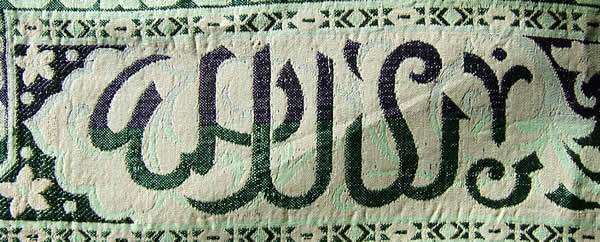
Evans Knight suggests that the 'writing' doesn't actually say anything at all. It seems that it was just arbitrarily designed to simulate the Arabic script.
Carl Mashtay thinks that the writing is Arabic and is the latter half of "(laa 'laah) ilaa 'llaah" '(There is no God) but God@
Aniruddha Basu thinks that the writing is "laa ilaah illa Allah" (there is no God but Allah). The initial alifs are consistently joined to the ensuing laams, not a very unusual practice. The final 'h' of the "ilaah", though, seems to be missing - may be we can take it as artistic license.

The inscription is Sanskrit and reads "Om Namaha Shiva(ya)", which means "I bow to Shiva" and is a mantra used for meditation.

Here's a possible translation of the inscription:
Ma'andil Fayn-shtayn [Mendel Feinstein]
noladah po rosh hodesh shivat 5665 (born here in first of Shivat, year 5665)
Sherah Fayn-Shtayn (the noble Feinstein)
niftarah po hamasha 'ashar 5682 (died here in Iyar, 15th, year 5682)
The years are in Hebrew calendar: 5665 is almost equivalent to 1905 and 5682 is almost equivalent to 1922.
מענדיל פיינשטיין
נפ[טר] ר[אש] ח[ודש] שבט תרס"ח
שרה פיינשטיין
נפ[טרה] ט"ו אייר תרפ"ב
Mendel Feinstein
passed away Rosh Hodesh (the first of the month of) Shevat 5668
Sarah Feinstein
passed away 15 Iyar 5682
(These dates correspond, respectively, to Jan. 4, 1908, and May 13, 1922.)
Typically you would find such a memorial plaque on the wall of a synagogue, or on a Jewish ritual object donated to a synagogue.

The Hebrew inscription seems to be a memorial for a lady called Ester Mizrachi (and the Mizrachi family is one of few jewish families that remained in Egypt after the formation of Israel).
Although lot of words couldn't be read because of the low quality pictures, and the use of Gershayim (signs used in hebrew for abbreviations), it seems that the lady is called "the virtuous of all women" or "the purest of women." With some acronyms it seems that she died in February or the month of Shbat according to the hebrew calendar.
The few words that could be read are:
t-t-h-l-l (to be praised)
ha-Kosherah b-nashim (virtuous of women)
B-Shb''t (acronym) min ha-'olam (february, from this world)
Ester (Aster) Mizrachi
Yahodah Na'arah (young jew)
It's a tombstone and the inscription reads as follows:
מ[קום] ק[בורת]
אשה יראת ה' היא תתהלל
הזקנה הכשרה בנשים
הנפטרת בש[ם] ט[וב] מן העולם
מ[רת] אסתר מזרחי נ[שמתה] ע[דן]
אשת המ[כובד? נוח?] משה יהודה מזרחי
נ[לקחה] לב[ית] ע[ולמה] יום כ"א לח[ודש] מרחשון
ש[נת] התרפ"ד
The place of burial of
a woman who fears G-d, she shall be praised
the elderly, most virtuous of women
who leaves this world with a good name
Mrs. Esther Mizrahi, her soul is in Eden
wife of the (honored? late?) Moshe Yehudah Mizrahi
brought to her eternal rest on the 21st of the month of Marcheshvan
year 5684
(The date corresponds to Oct. 31, 1923.)
Can you make out the writing on this coin? It was sent in by SuAnne Droddy, who has worked out part of the inscription: "... minted in Constantinople 1327". Please send your suggestions to sdroddy@uark.edu.

According to TJ, the inscription reads:
(glorified his victory) عز نصره
(minted in) ضرب في
(Constantinople) قسطنطينية
(1327) ١٣٢٧
This scrap of paper was found in a bottle floating in Horsens Fjord, Denmark. The alphabet (Arabic) and prevailing ocean currents would seem to indicate that its origin is to be found in the west of North Africa (maybe Morocco). If you can make any sense of it, please contact Jens Bilgrav - isp-30[at]fak[dot]dk

The paper is definitely a talisman and the scattered letters have no meaningful occurence linguistically ... but someone with occult knowledge of letters would understand what they signify.
The phrase on the top right is: بسم الله الرحمن الرحيم (Besmilláh Al-Rahmán Al-Raheem), which means "In (by) the name of Allah, the Beneficent, the Merciful." A famous phrase that should be said before starting reading Quran (or even before doing anything, for blessings).
Brian Fisher sent in this image of a mysterious book which he believes comes from Africa. The book is made of wood with bone covers. If you have any suggestions, please contact Brian at: sales@kotikiinteriors.co.uk

Brian has discovered that the writing is in the Toba Batak Script of Sumatra, Indonesia and that it's a book of divination called Pustaha.
Can you recognise or read the inscriptions on this knife? If you can, please contact Mike Wochna at mwochna@comcast.net.

According to TJ, the writing in the first photo is in the Arabic script and probably in the Uyghur language. It reads ئهخمهت, which is a-xma-t or axmat in the Latin alphabet. This is a Turikic verison of the Arabic name Ahmed - probably the name of an owner of the knife.
Mike has now discovered that the knife comes from Yengisar in the Xinjiang Uyghur Region of northwesterrn China. So it looks like TJ is correct.
Pavan Periwal would like to know what language the inscription on this coin is in, what it means, and the approximate age of the coin. If you can help, please contact: p_periwal@hotmail.com

Here's some information about the coin from TJ:
Can anybody identify this symbol? It looks like a Chinese character, but I can't work which one. If you can, please contact: MIC307@aol.com

The symbol is a version of the Chinese character 壽 [寿] shòu, which means 'long life'.
This mysterious writing was sent in by Doc. G. Bancalà and is inscised on a brass plate on a chest. The alphabet looks like Gujarati. Can anyone decipher it? If you can, please write to pianetaterra06@hotmail.com

The inscription on the chest reads as follows:
Rawla Damodar Viswanath rahewasi Gosahunava naa chhe Savan na Chaitar sudi :2: var ravivar.
From the house of Damodar Viswanath [name of the person or the family name of the house], the resident of Gosahunava [name of the place], was no more on Sunday the second of the month of Chaitra in the year of sanvat [1989].
 The image on the right was sent in by Glenda Fessenden
(chantily@lsbg.net).
It belonged to Glenda's grandfather, who lived in China before WW2. It was
apparently made for him as an honor. Glenda would like to know if anybody
can decipher the characters or provide any information about the age of
the medallion.
The image on the right was sent in by Glenda Fessenden
(chantily@lsbg.net).
It belonged to Glenda's grandfather, who lived in China before WW2. It was
apparently made for him as an honor. Glenda would like to know if anybody
can decipher the characters or provide any information about the age of
the medallion.
The characters are 齊肖公柬 (qí xiào gōng jiăn). The first means "equal, uniform", the second means "to resemble", the third means "unselfish, unbiased, fair, public" and the fourth means "a letter, an invitation, a card, or to select". What they mean together we don't know.
The character "qí" probably refers to the kingdom of Qi of the 3rd century BC because the shape of this medallion is very similar to the ancient currency of Qi.
The writing probably means "sent by (given by?) Xiao of Qi" The 4th character could mean letter, send etc. The 2nd and 3rd identify the sender as a man with the surname Xiao With the first character, Qi, I suppose it's a gift tag of sorts.
This photo was sent in by Fred Ganous (hawktuner@earthlink.net), who found the stone featured in it in Kosovo. The inscription looks like (Old) Church Slavonic to me, but I'm not sure. Can anybody help?

The lower half of the inscription appears to be a variation of the traditional Christian logo found in the Middle East. The 4 quadrants are formed around a cross and represent 3 words:
IC [with the contraction bar] are the first and last letters of the word for JESUS [roughly, IESOUS].
Similarly, the XC [with the contraction bar] are the first and last letters of the word for CHRIST [roughly, CHRISTOS].
Hence the Logo with the Cross means, "Jesus Christ, Conqueror". This is a common logo in many of the Eastern Rite Churches, Greek, Russian, etc (Catholic as well as Orthodox).
Can anybody decipher this inscription? If you can, please contact me.

According to Francisco Peña Blas, the inscription is "3quir 3quo u3ur cnodar", which may be translated into "SEquir SEquo uSEur CAnodar" > "sequir sequo usura canodar". This could be Ido mean something like "Follow a sequence become usury" or "Take it easy!".
According to TJ, the first word could be gequir. which means "to leave" in Occitan, or it could be sequir. The third word could be "ugur", "ugus", "uzur", "uzus", "usur" or "usus".
According to Paolo Sartori, the inscriptions reads "et quis et quo vetus"
Do you have any ideas what the symbols on this Medallion mean? If you do, please write to Alicia: summonersoul@yahoo.com
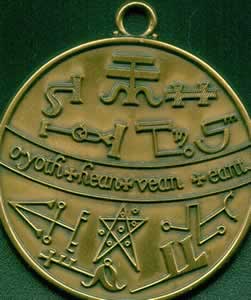
According to Robbie Hart, the symbols on the top are defintely of alchemical derivation, though the only one that is really clear is the top middle character, which can mean either 'cadmium' or 'arsenic'. The symbol to the left of it could be 'lead', turned sideways, and the element below that appears similar to a cursive superscript 'M' can refer to the alchemical process of seperation. So he would hazard a guess that the medallion is a spell, charm, recipe, or the like.
This inscription appears on a coin bought in Greece. It has a picture of St. George on the obverse. If you can decipher the inscription, please contact Joni Hickey at: akpurple12@yahoo.com

The coin might be Byzantine and the inscription reads "SPHRAGIS IONOU TOU IS(O)U". The first two words could mean something like "Ionos's seal" or "seal of the Ionians". The second two perhaps "[on the basis] of equality".
While doing some research on the catholic church, Marco Alexandre (marcoalexandre77@iol.pt) found the following image, which appears to be a Latin prayer translated into an unknown language/alphabet. Any ideas?

Salve Regina, Mater misericordiae
vita, dulcedo, et spes nostra salve.
Ad te clamamus, exsules filii Hevae;
Ad te suspiramus, gementes et flentes
in hac lacrimarum valle.
Eia ergo, advocata nostra
illos tuos misericordes oculos ad nos converte,
Et Jesum, benedictum fructum venris tui,
nobis post hoc exilium o stende.
O clemens, O pia,
O dulcis Virgo Maria.
The alphabet is unknown but the language is some kind of old Portuguese.
Salve Rainha
Salve Rainha Maim de mizericordia
vida dusura esperamsa nosa salve
A vos bradamus us degredadus filhus de Eva
A vos suspiramus jememdu i xuramdu
neste vale de lagrimas
Aia pôis adevogada nosa
eses vosus olhus mizericurdiozus e nos volvai
depôis deste desterro mustrainus Jezus
bemditu frutu du vosu vemtre
O clememte o piedoza
O dôse sempre Virjaim Maria
Rugai pur nos samta Maim de Deus
Para qe sejamus digenus das prumessas de
Cristu
Salve Rainha
Salve Rainha Mãe de misericórdia
vida, doçura, esperança nossa salve
A vós bradamos os degradados filhos de Eva
A vós suspiramos gemendo e chorando
neste vale de lágrimas
Eia pois advogada nossa
esses vossos olhos misericordiosos a nos volveis
depois deste desterro mostrai-nos Jesus
bendito fruto do vosso ventre
Ó clemente ó piedosa
Ó doce sempre Virgem Maria
Rogai por nós santa Mãe de Deus
Para que sejamos dignos das promessas de
Cristo

The script is northern Tham, of which Lanna is the standard form. The language is Thai. The origin is north Thailand. I think the text is a form of proverb. I am a little uncertain of the first line, so I offer 2 versions. The first follows the script more closely; the second allows variation, but makes more sense.
Transliteration
(lid; using tone numbers 1 2 3 4 for low, falling, high, rising)
[1] poen lao2 taan-jaa khuan |
[2] koen lao2 kaan-jorn chuan |
lab1 khaw4 hue2 dai2 ngoen muen1
tuen1 khaw hue2 dai2 ngoen saen4
khon booraan pen khon jai-bun
Translation [1]
Poen told Taanjaa (that he might be) persuaded:
Asleep, beg for funds 10,000;
Wake and beg for funds 100,000.
People of old were benevolent people.
Translation [2]
Too much liquor (and for) casual expenses (you must) persuade (someone):
On going to bed, beg for funds 10,000;
On getting up, beg for funds 100,000.
People of old were benevolent people.
[a current anti-drink advertisement on Thai TV presents a similar image]

According to Vic Fieger, this is probably Gregg shorthand and reads "South side door is unlocked".
The inscription on this bell, which is apparently a camel bell, is in the Devanagari alphabet.

According to an Indian friend of TJ, the inscription is the name of a person, Mabaasaaram Jagadish Prasad from the town of Jalesar.
This inscription appears on a house in Bucharest, Romania. The writing is in the Devanagari alphabet.

According to an Indian friend of TJ, the writing is most likely the name of the owner of this house and reads Edal Dutch, who probably spent time in India.

Apparently the symbols on this table are simply used for decoration and don't mean anything.
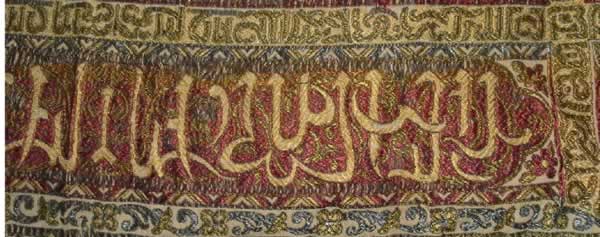
According to TJ, the writing is Arabic and reads لا إله إلاّ الله (Laa ilaha illa Allah), which means "there is no god but Allah". This kind of rug would normally be hung on a wall.
The photo below shows part of a rug that was apparently bought in Kashmir. The rug seller claimed that the writing was Arabic.

The writing starts from the middle, after the flower, going from there right to left. The half of the inscription on the right hand side (from the right hand corner to the flower in the middle) is a perfectly symmetrical copy of the writing on the left half. It is the words 'alaihi ("on him" , or "on it") and Allah (Muslim name for God) both written twice. The first word 'alaihi is written with minor calligraphic errors, but Allah is written flawlessly.
In the latter half of the 90's in Pakistan the name of Allah started appearing on carpets and rugs, on the underside of shoes, on musallas, on the seats of chairs etc. The Islamic newspapers made a lot of hue and cry, and claimed that it was a Jewish plot to disrespect the name of Allah by printing on products which are sat or trodden on. None of the products had the name of the manufacturers, and after threats were made that the manufacturers will be traced and lynched, the products disappeared from the market. This carpet seems to be from the same time.

According to TJ, the inscription reads رضافٍ خرانرد
(Ridhali Kheraverd), which seems to be the name of the maker of the ring. Ridhali is a
combination of two names, Ridha and Ali
(رضا+غفٍ)
and combining names like this is common habit among Persians.
According to k., Khodaverd is more likely to be a Turkish surname - in modern Turkish the name would be "Riza Ali Hudaverdi".

According to TJ, this is a replica of the alchemical Key of Solomon talisman that was used to increase one's overall happiness and success in life by balancing the planetary powers. The bearer of this talisman was said to be protected from all devious spirits and negative energy.

According to TJ, the writing on the key is a bunch of random Arabic letters and doesn't mean anything. He thinks the key might be some sort of talisman.

The writing is the weaver's first name, first initial of her father's name, then - first initial of her last name, and the date (day/month in Latin/year): Anik Kh. A. 11/XII/55 y.

According to TJ, the writing says "maa shaa'allah" (ما شاء الله). This literally means "as God wills" and is the phrase that Arabic-speaking people usually use when they see something abundant, beautiful or amazing.

According to AH, the text on this coaster is in the Cyrillic alphabet and reads Чешcкая пивница (Cheshskaya pivnitsa) - Czech beer pub. Googling it turns up some references to a business of that name in St. Petersburg, Russia
The devices in the center are half of the emblem of Russia (a double-headed eagle) and half of the emblem of Bohemia (a two-tailed lion rampant).

According to TJ, this piece is a Sura from Quran. See the following links:
Arabic text
www.sacred-texts.com/isl/uq/112.htm
English translation
www.sacred-texts.com/isl/pick/112.htm
 According to Ross Kirsling, the Chinese on the scroll reads:
According to Ross Kirsling, the Chinese on the scroll reads:
願以此功德普及於一切
我等與眾生皆共成佛道
(yuan4 yi3 ci3 gong1 de2 pu3 ji2 yu2 yi1 qie4
wo3 deng3 yu4 zhong4 sheng1 jie1 gong4 cheng2 fo2 dao4)
It comes from Chapter 7 of the Lotus Sutra, apparently, and means:
"We beg that the merit gained through these gifts
may be spread far and wide to everyone,
so that we and other living beings
all together may attain the Buddha way."
Information about the Lotus Sutra can be found at:
http://www.sgi.org/english/Buddhism/lotussutra.htm
http://www.sgi-usa.org/buddhism/library/Buddhism/LotusSutra/
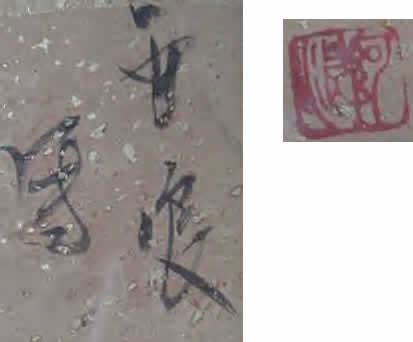
According to a Chinese friend of TJ, the signature is of a famous chinese artist: 马玉良 (Mǎ Yùliáng)
 The symbol is most likely the Hindu/Buddhist "AUM" or "OM" sacred syllable,
as written in the Siddham script or in a script similar to it. One may notice
however that the upper horizontal stroke of the "A" has been merged with the
"candra" (half-moon). Moreover, the meaning of the three tiny dots (placed
vertically) on the far-right is unknown.
The symbol is most likely the Hindu/Buddhist "AUM" or "OM" sacred syllable,
as written in the Siddham script or in a script similar to it. One may notice
however that the upper horizontal stroke of the "A" has been merged with the
"candra" (half-moon). Moreover, the meaning of the three tiny dots (placed
vertically) on the far-right is unknown.
According to TJ, the symbol looks like the Siddham symbol vahm, and the dots denote aspiration. He got this from: http://www.mandalar.com/DisplayJ/SJapan.html



This text comes from the Quran - part of surah 4, phrase 77.
qul mataAAu alddunya qaleelun waal-akhiratu khayrun limani ittaqa
Say: 'Short is the enjoyment of this world: the Hereafter is the best for those who do right;'
(Yusuf Ali translation)
Say, 'The enjoyment of this world is but slight, and the next is better for him who fears;'
(Palmer translation)

According to Nikhil Sinha, the writing is Devanagari. The top bit reads ja: 3:98 (or 88 or 99), while the bottom bit reads go:2:30. He doesn't know what this means though. It may just refer to some passage from a text, like the way you do in the Bible.
Apparently the numbers refer in the place in the armory where the weapons were stored.




The date 1223 AH is almost equivalent to 1808 AD, which was the year the sultan Mahmood came to the throne after his brother. Mahmood (in modern Turkish now it's written Mahmut) is also called Mahmut II.
The question was whether you could decipher the script at: http://nabataea.net/manus.html. Apparently the script is Old Javanese.
The image below is of a copper coin found in southern Germany and sent in by Philipp Weig (tschengpeng@web.de). Can anybody identify the script on the coin?
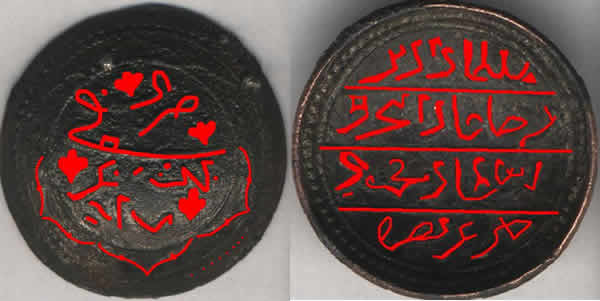
According to Sami Kleit, the script on the coin is an old Middle Eastern script from about 600 BC closely related to Nabatean, and the old scripts of Arabic and Hebrew. The language is either Nabatean, Aramaic or Syriac.
The writing is definitely in the Arabic script and in Arabic.
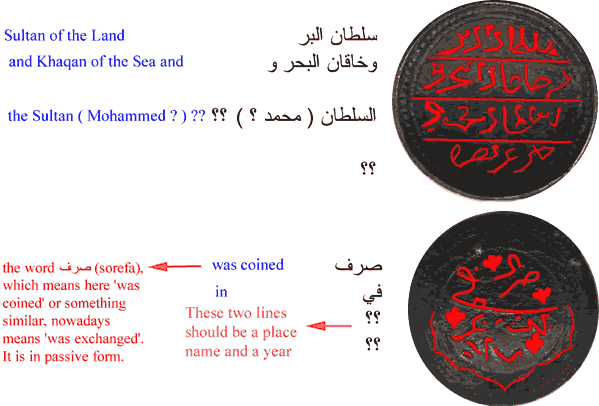


 The writing on the right reads "Masheeh (Malooka) Shalom v'Ares
Arem 'Itavi Hu". This probably means "Messiah, the promise of peace and the protective
name. My protection is he." Some words had been cut with the rest of the word
on next line.
The writing on the right reads "Masheeh (Malooka) Shalom v'Ares
Arem 'Itavi Hu". This probably means "Messiah, the promise of peace and the protective
name. My protection is he." Some words had been cut with the rest of the word
on next line.
On the other side of the coin, the letter on the right is "Aleph", which denotes the "One" (its numerical value is also one) and it is the sign of Lord in Kabbalah and the ultimate light. The other symbol is a feast or a hand, or "the feast of Lord."
This medalion or coin is a kabbalistic piece intended to try to bring what is called the tikkun, something that helps to balance the forces in life.
For more information about the tikkun, see: http://www.yashanet.com/studies/revstudy/rev5hd.htm
According to Simcha Kuritzky, this piece was made by Christian kabalists. The 'fist' before Jesus' face is in fact the Hebrew inscription Yeshu (yod shin vov), which was accepted as one of the Hebrew spellings of Jesus' name.
Apparently the second letter in the first word is a tet not a shin so this word should read metayah. The first letter could be a mem or a samech. The second line of the coin should read maloocha and at the very end of that second line there are two letters, a chaf and a shin, which makes the word chash. The second word in the third line could read ares or it could read arem.
Karen Barnett found this coin on a bank of the Ohio River.

The coin appears to be a copper imitation of a Castilian "Real de Plata" (Silver Real) of the Catholic Kings. It is a coin from the last years of the 15th century and the beginning of the 16th.
The picture on the left is the front, with the coats of arms of the Kingdoms of Castile, Leon, Aragon and Granada, and the Latin inscription "Fernandus et Elisa" (Ferdinand and Elizabeth/Ysabela).
The picture on the right has a yoke and some arrows tied together, symbols of the unity of Hispanic kingdoms, and the Latin inscription "Rex et regina de Castella legina".
The arrows (flechas) are for Ferdinand and the yoke (yugo) for Ysabela.
This postcard was mailed from Brooklyn, NY, is addressed to Hanni Dittrich in Dresden, Saxony, Germany, and is dated 1904.

See a larger version of the above image
The postcard is in German, though written in a very strange kind of handwriting. So, for instance, III is M; \ is E; and II is N; - is B; and so on. Punctuation is quite arbitrary; most words are seperated by semicolon; there are no periods and no capitals. Additionally, there are a lot of terms of endearment I never learnt to translate at school... So this is what I found out, starting at the top, by lines:
Mein Herz, herzinnigst, einziggeliebtes, gutes, herzteures Herzhannichen! Meinen Brief vom 22. Okt. hoffe ich in Deinem Besitze. Heute abend erhielt ich unter grosser, grosser Herzensfreude Deine lieben, niedlichen Kärtchen vom 12. Okt. Herzlichsten Dank dafür, mein Herz, herzliebes, gutes Herzliebchen! Hoffentlich hast du mir das versprochene Briefchen in den ersten Tagen voriger Woche geschrieben, damit ich solches morgen oder übermorgen früh erhalte. Ich freue mich schon unbeschreiblich darauf. In Zukunft schreibe mir, mein herzinnigstgeliebtes Hezblättchen, nur stets rege. Nächsten Montag und Donnerstag bis mittags musst du aber mit (deinen - canceled) Schreiben damit sie den Dampferanschluss noch rechtzeitig Mittwoch und Sonnabend früh erreichen!
My heart, heartfelt, only beloved, good, dearest heart-Hannichen(=name)! My letter from oct. 22 I hope to be in your possession. Tonight (I) got in great, great joy of heart your kind, cute card(let)s from Oct. 12. Hearty thanks for that, my heart, beloved, good Darling! Hopefully you (wrote) to me the promised letter in the first days of the last week; so I'll (get) that one tomorrow or the the day after in the morning. I'm already looking forward to it ineffably. In future write to me just quite briskly, my heartfelt beloved sweetheart. (But) Next monday and thursday you must (have finished) (your - canceled) writing so they (will catch) the steamboat connection still in time on wednesday and saturday morning.
Right side vertically:
/Dass es der lieben Grossmutter/ besser geht und sie das Bett.../
That the dear grandmother feels better and she (has left) the bed...
Left side:
/nun verlassen hat, freut mich/ sehr. Grüsse sie bitte von mir herzlichst!/
now, makes me very glad. Please send my love to her.
Bottom:
/Gestern vormittag holte ich mit Freund Vollmer(?) Mr. Hasbler(?) vom Dampfer/
Yesterday morning me and friend Vollmer (picked up) Mr. Hasbler from the steamboat.
/ab. Er hatte einen grossartige Reise, schönes Wetter, ruhige See, von/
He had a great journey, good weather, calm sea, from

"Tanto Monta, Monta Tanto" was the motto that appeared on the Spanish Royal Standard of the Catholic Kings from 1492-1506. It refers to both Catholic monarchs: Isabella and Ferdinand and loosely translates as: "As much as the one is worth, so much is the other". This meant that the King and Queen held equal authority.
According to Ronald Kyrmse, the rest of the inscription seems to read "MEMENTO MEI O / MATER DEI MEI", which is Latin for "Remember me, o mother of my God".
There is some discussion about this sword at: http://www.bladeforums.com/forums/archive/index.php/t-194229.html
A number of you have sent solutions to this puzzles to Shirlene, however she has been having problems with her email and has lost those messages. Could you re-send them to her, and copy me in? Thank you.
Puzzles archive 2 | Unsolved puzzles
[top]
You can support this site by Buying Me A Coffee, and if you like what you see on this page, you can use the buttons below to share it with people you know.

If you like this site and find it useful, you can support it by making a donation via PayPal or Patreon, or by contributing in other ways. Omniglot is how I make my living.
Note: all links on this site to Amazon.com, Amazon.co.uk
and Amazon.fr
are affiliate links. This means I earn a commission if you click on any of them and buy something. So by clicking on these links you can help to support this site.
[top]